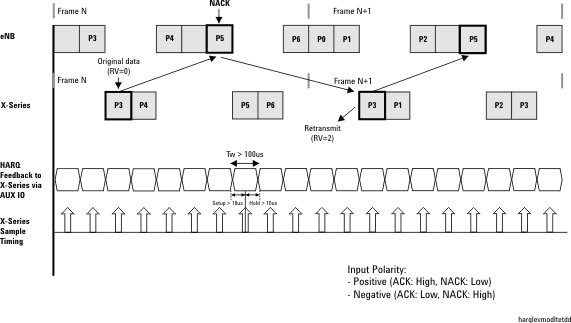
The figure below shows a timing diagram for the LTE TDD uplink HARQ process between the eNB and UE (X-Series). The uplink HARQ processes number depends on the UL/DL configuration. HARQ process length is the same as a subframe (1 ms). When the UE sends data to the eNB, the eNB decodes the data and checks CRC. The eNB then sends acknowledgement (ACK) or not-acknowledged (NACK) to the UE after certain subframes. Based on the eNB response, the UE will send new data or retransmit the same data with a different redundancy version (RV).

On X-Series with multiplexed mode, X-Series samples AUX IO input level at the specified delay within a 100-us window. If the level is high (with input polarity settings set to positive), it detects as an ACK, and if the level is low, input is NACK. This delay specifies the timing of the eNB’s initial HARQ response from the start of frame. All of subsequent processes use the same delay time. Because it is a TDD system, both the eNB and UE side need to be fully synced before communication happens, so the HARQ Input Delay settings for AUX multiplex mode should be set to 0. Although the sampling window has a 100-us width, it is recommended to hold input level high/low for the entire subframe length (1 ms) to ensure the X-Series detects the command.
TDD has different HARQ timing scheme from FDD, as it has a different uplink and downlink slot allocation, based on UL/DL configuration. All of TS 36.141 receiver performance test configuration requires TDD UL/DL configuration 1, which has the same number of UL and DL subframes, thus each specified downlink subframe carries one HARQ ACK/NACK (IPHICH=0) to correspond to the uplink subframe. For UL/DL configuration 0 with more UL subframes than DL, PHICH carries 2 HARQ ACK/NACK, which is identified by IPHICH = 0 and 1 to indicate ACK/NACK for 2 UL subframes.
When IPHICH=0, the received HARQ ACK/NACK corresponds to the UL subframe i-k from the following table. For example, when HARQ is received on subframe 1, it refers 1-4=-3, which refers subframe 7 in previous frame.
|
DL subframe (i) |
0 |
1 |
(2) |
(3) |
4 |
5 |
6 (DwPTS) |
(7) |
(8) |
9 |
|
k for IPHICH=0 |
|
4 |
|
|
6 |
|
4 |
|
|
6 |
|
Corresponding UL subframe(i-k) |
|
7 (prev. frame) |
|
|
8 (prev. frame) |
|
2 |
|
|
3 |
Sampling timing for HARQ feedback signal on X-Series will be determined automatically based on the UL/DL configuration for LTE TDD HARQ. HARQ input delay (level triggered and serial bits) must be set to 0 for LTE TDD.
The detected HARQ input can be monitored using marker output type, “Hybrid ARQ State.”
With multiplexed mode, timing advance (TA) input can’t be used.